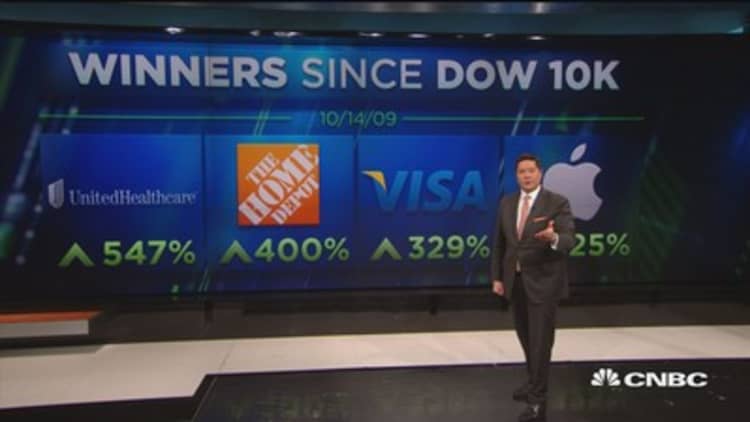
U.S. stocks rose on Thursday as a post-election rally resumed, while investors digested a slew of economic data and the Federal Reserve's decision to raise interest rates.
"It appears that this rally has more room to run and the Fed rate hike can not stop this. The US home builders data has confirmed that the housing market is strong and it echoes what Janet Yellen said last night. All eyes are pinned towards that 20K mark for the Dow and bulls are once again in charge of the market," Naeem Aslam, chief market analyst at Think Markets, told CNBC in an email.
"This is despite the fact that we are seeing some carnage in the currency market especially if you look at the dollar against the Euro. The pair has made another low against the dollar which we have not seen since 2003," Aslam said.
That said, Robert Pavlik, chief market strategist at Boston Private Wealth, said the market might be starting to show signs of exhaustion. "I think, however, we're still in a long-term bull market; in the short term, I think we're a bit over-extended," he said.
The Dow Jones industrial average closed about 60 points higher, having risen more than 150 points earlier, with Goldman Sachs contributing the most gains. At one point, the Dow was about 50 points away from hitting the 20,000 mark. The S&P 500 gained 0.4 percent, with financials rising around 1 percent to lead advancers. The Nasdaq composite also advanced 0.4 percent.
The U.S. central bank increased rates for just the second time in a decade on Wednesday, as was widely expected. The Fed, however, also projected three rate hikes for next year, with most market participants expecting a forecast of two increases.
Since then, the dollar index has rallied sharply, trading 1.34 percent higher at 103.12 on Thursday, hitting a 14-year high. The euro, meanwhile, fell 0.54 percent to $1.0414.
Dollar index (Oct. 2002-Now)
Treasury yields have also spiked sharply, with the benchmark 10-year note yield hovering around 2.6 percent, while the traded around 1.26 percent.
"You've seen the two-year note rise about 10 basis points from yesterday, said Matt Toms, chief investment officer of fixed income and Voya Investment Management. "That's showing the market is baking in a potential third rate hike next year."
Stocks, however, sold off following the Fed's announcement on Wednesday, with the Dow falling more than 100 points, while the Russell 2000 falling 1.27 percent. U.S. equities have experienced a sharp rally since Donald Trump's presidential election win, with the major U.S. indexes hitting all-time highs.
"You were looking at a market that was looking for a reason to sell off," said Art Hogan, chief market strategist at Wunderlich Securities. "Beyond the Fed, there is no macro roadblock through the end of the year. Flip the calendar over, then you have a few things, including the fact that January has been sloppy for the past two years."
Optimism surrounding some of the president-elect's proposed policies — including deregulation of certain sectors and tax cuts — have flooded the market since Nov. 8, propelling the market higher.
Hogan also noted the market has been lifted, in part, by a massive sector rotation. "In the first three quarters of the year, you could pull up the leadership list and it would look the same, with the difference being the order of magnitude," he said. "Now, you could be in the top 5 and the bottom five within the same day. That's people trying to adjust to the changing environment in real time."
In economic news, CPI (Consumer Price Index) rose 0.2 percent in November, in line with expectations. Weekly jobless claims, meanwhile, came in at 254,000. The Philadelphia Fed business index rose 21.5 in December, versus a November read of 7.6, while the Empire State manufacturing index rose to 9.0 in December from 1.5 in November.
"The current economy has exhibited some small signs of burgeoning momentum albeit GDP is poised to fall short of 2.7% for the eighth quarter out of the past nine. I therefore find it puzzling that the Fed would hint at choking off the recovery by boosting its expectations for the number of overnight rate hikes it administers in the coming years," Jeremy Klein, chief market strategist at FBN Securities, said in a note.
Investors also digested manufacturing data from IHS Markit, with the December manufacturing PMI index coming in at 54.2, marginally above November's 54.1. A number above 50 indicates expansion within a sector. "Manufacturing output expanded for the seventh consecutive month in December, thereby signalling a sustained rebound from the soft patch seen in the second quarter of 2016," IHS said.
The NAHB homebuilder sentiment index rose 7 points to 70, easily beating expectations.
In oil markets, U.S. crude for January delivery settled 0.27 percent lower at $50.90 per barrel, as the rising dollar hit commodity prices. Gold futures for February delivery, meanwhile, fell $33.90 to $1,129.80 per ounce.
Major U.S. Indexes
The Dow Jones industrial average rose 59.71 points, or 0.3 percent, to close at 19,858.24, with DuPont leading advancers and United Technologies the top decliner.
The gained 8.75 points, or 0.39 percent, to end at 2,262.03, with financials leading nine sectors higher while consumer discretionary and real estate lagged.
The Nasdaq composite advanced 20.18 points, or 0.37 percent, to 5,456.85.
About four stocks advanced for every three decliners at the New York Stock Exchange, with an exchange volume of 987.25 million and a composite volume of 4.059 billion at the close.
The CBOE Volatility Index (VIX), widely considered the best gauge of fear in the market, traded near 12.7.
On tap this week:
Friday
8:30 a.m. Housing starts
*Planner subject to change


